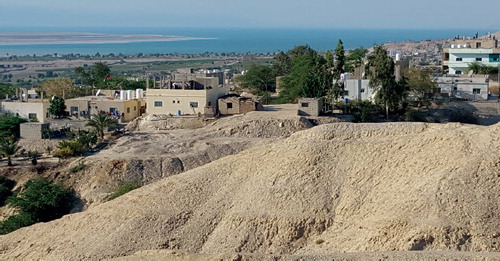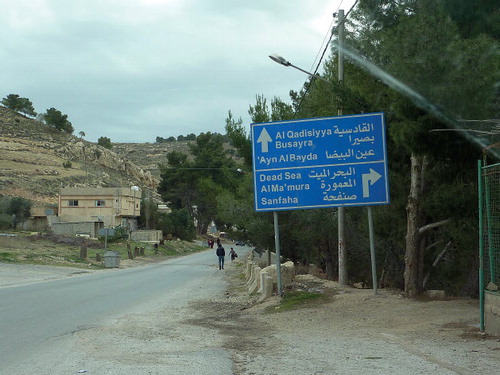Across the Arab world, rapid social changes, technological development and increasing migration go hand-in-hand with changes in language. With large-scale migration into cities, complemented by marginalization and/or stigmatization of rural settlements and simultaneous increased exposure to the prestige of the urban lifestyle, comes the erosion and potentially the disappearance of traditional rural lifestyles. With that erosion follows the erosion of rural identities, one major aspect of which is linguistic.
The observation that the old rural traditions and ways of life are rapidly dying out had occupied a number of conversations that I had with Carol Palmer, CBRL British Institute Amman Director, over the course of recent trips to Jordan and Syria. From these conversations was born the idea for a project, the pilot phase of which constitutes my recent CBRL Senior Visiting Fellowship, which I undertook from January to April 2016, based at the British Institute Amman. Over the years, Dr Palmer had herself recorded and documented data with rural communities around Jordan resulting in a collection of audio recordings which had not been fully exploited, at least not for their linguistic interest. Of primary interest were her recordings of oral narratives on traditional ways of life and material culture in al-Ramthah, Tafilah and Ghawr al-Safi. I applied for a CBRL Senior Research Fellowship that would allow me three months’ research leave, to undertake a pilot study. This was originally planned as the initial phase of a project to investigate, document and analyse three varieties of rural Jordanian Arabic, focusing on dialect variation and women’s speech within the context of disappearing rural traditions. The three month fellowship enabled me to travel to Jordan to work with Dr Palmer to assess the existing corpus of data, to build on institutional links with native- speaker consultants in the field, and to work out the details of a longer-term project (including what further collection of primary data would be needed).
Much of the period of the fellowship was spent undertaking field trips, both to evaluate and to begin gathering relevant data, as well as to identify and to start working with native-speaker consultants. I undertook a number of trips: some alone and some in collaboration with Dr Palmer, and on a couple of occasions with other colleagues or Fellows at the British Institute Amman (one of the various benefits of working in the multi- disciplinary community that the Institute provides). I took an ethnographic approach to fieldwork, which involved staying with families and participating in activities and gatherings, a number of which were the domain of women. In addition to the lasting friendships that this facilitates, it has also yielded a good amount of data, both linguistic and anthropological, to inform the next stage of the project. In addition to the previously existing recordings noted above, I made a total of 182 audio and audio-visual recordings constituting in total just over 31 hours and 22 minutes. These were recorded in several locations.
With my colleagues Dr Palmer and Myriam Ababsa, I spent a very sociable evening visiting a family in al-Ramthah in the Hawran, a region that straddles northern Jordan and southern Syria, al-Ramthah being just across the border from the Syrian city of Dar’aa. Dr Palmer and Myriam knew the family well, having worked with them previously as part of a study looking at changing demographic patterns, and already had an impressive archive of video footage of several generations of the women of the family. I made an audio recording of part of the evening’s conversation that will aid in evaluating linguistic features of speech that are associated with the northern rural dialects of Jordan, and will help to provide further data on language change in Jordan. Interestingly, the oldest member of the family claimed that her great-grandchildren don’t always understand her because they are not fully proficient in the local dialect that she speaks.
The major source of recordings proved to be several trips I made to the southern Jordan Valley area, where I was very lucky to be invited to stay with families in two villages. I recorded in Ghawr al-Safi, Ghawr al-Mazra’ah, Ghawr al-Hadithah, Fayfa and al-Naga’. Of the audio recordings, some were on my solid state recording device, in WAV format, before the curse of fieldwork struck and my recorder developed a problem reading the SD card. Fortunately, this happened while I was checking all my equipment, back in Amman, before heading off on one of the trips, and I was able, on the way to the bus station, to buy a good quality Olympus voice recorder. This recorder preserves audio files in MP3 format, rather than a lossless format like WAV, but the quality is still good enough for initial data gathering that I shall use to inform more specific research questions on future visits.
On these trips to the southern Jordan Valley, I also made a number of video recordings, having bought my first ever smartphone while I was in Amman (mainly for fieldwork purposes), i.e. taking and exchanging photos, making video recordings, and having internet access via mobile data (which of course is not always a good thing when one is aiming to focus on research with no distractions!). I discovered three immediate bonuses to having a smartphone. Firstly, taking pictures and recording seems markedly less intrusive than it used to be. Smartphones are now so common that most people are also taking photos and videos and so the fieldworker is less obvious and recording more normalized. This may mean that the recorded data is less likely to be biased by participants feeling awkward in the face of a huge microphone, or because a participant expects that since she or he is being recorded, she or he must try to speak more formally and less colloquially (which is not what a dialect researcher wants!). A second benefit was that I was able to take lots of photos that I could then instantly send via an app on the phone. This meant that I wasn’t just ‘taking’ a recording, but I was also ‘giving’ photos, and that both participants and fieldworker would all be taking photos and sharing them, thus equalizing the relationship. Thirdly, since leaving Jordan, I have been able, very easily, to keep in contact with the families I stayed with, and therefore maintain a friendship.
The recordings I made on these trips to the Ghawr area were of different types. Many recordings were free conversations at home with the family and with delegations of visitors, or with neighbours and extended family. There were many weddings taking place around the time I was there, and the women were very generous in extending hospitality to me and inviting me to the women’s henna parties (one day we went to five!). At some of these I was allowed to record the conversations and singing of both older and younger people. In addition, I conducted and recorded some more formal interviews.
The remaining recordings were made on trips further south to Ma’an—which is towards the Saudi-Jordanian border—and Wadi Musa, most well known as the gateway to Petra. I was very lucky to have been introduced to a sociologist colleague from Al-Hussein Bin Talal University, who hosted me in Ma’an and took me to visit people whom I was able to record. She also introduced me to her colleagues at the Princess Basma Centre for Intangible Cultural Heritage, and I went with them on a recording trip to an elderly lady in Wadi Musa; where both they and I interviewed her.
One other fieldwork trip was undertaken with colleagues to some villages near Tafilah, in particular al- Ma’tan, a mostly abandoned village interesting for its mountainside houses that reflect the traditional rural way of life in that part of Jordan. The trip involved the collection of both ethno-archaeological and linguistic data. Working mostly with the head of the Ma’tan Tourism Cooperative, I recorded data in the form of written transcriptions.
Some of the audio data gathered on these trips is now being transcribed, while some data is useful for background information and to answer specific questions. The transcriptions are multi-layered in that they include Arabic and Roman script, as well as linguistic glosses, translations into English and, where appropriate, standard Arabic, so that the data will also be usable by the speech communities. This makes data processing a lengthy, time-consuming task, and it is ongoing. Some of the data I have been able to start using already; while in Amman I gave a public lecture ‘In Search of Endangered Dialects’ as part of the joint Ifpo-CBRL Insights Series. I subsequently presented a talk ‘Whose Language? Disappearing Dialects, Disappearing Cultures’ at the CBRL-LMEI conference on ‘The Past in the Present of the Middle East’ at SOAS, London, in April. Then in May, I gave a lecture to the Friends of the Oriental Museum in Durham on ‘Disappearing Lifestyles, Disappearing Dialects?’.
The pilot exploratory phase of the project has been very successful in producing several outcomes. Firstly, I have been able to give three lectures discussing the project, the communities and the linguistic issues. In addition, I have collected an initial set of linguistic data, as described above, some of which I have already begun analysing. Data transcription has begun, with partial help from native speakers of two of the relevant dialects, who are thus gaining experience in transcription of dialect data. A further outcome is the development of a strong network of language consultants to work with, alongside consolidating links with other relevant researchers and organizations in Jordan. Another major outcome concerns plans for two longer-term projects. The pilot study has enabled me, in collaboration with Dr Palmer, to identify the scope of an ethno-linguistic project on rural women in Jordan—for which we are applying for further funding. In addition, time spent in the southern Ghawr (Jordan Valley) region has alerted me to the absence of material on the interesting dialects of this area, from both descriptive and socio- linguistic perspectives. This is the subject of a project that I aim to pursue concurrently with the collaborative project, and for which I am currently seeking funding. Lastly, some of the data gathered will contribute to a book that I am in the early stages of writing, on Arabic sound systems and their relationship to the sound systems of other Semitic languages and languages in contact.
I would like to thank the following colleagues and friends for their collaboration, time, help and hospitality: Bilal Dgheimat; Dr Aydah Abu Tayeh and Dr Maram Al Frehat; Umm al-Aseel and her family and neighbours; Umm Qusay and her family and neighbours; Sharifa and her family; Abu Samer (Hussein al-Shabatat); Dr Carol Palmer. I am grateful to the CBRL for funding the fellowship and research, and to the BIA for the welcoming community, facilities and the unfailing support of its staff.



